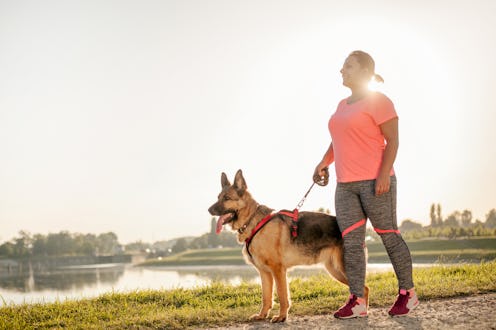
There are a lot of responsibilities that come with owning a dog. You have to be prepared to feed them around the same time each day (dogs love a good routine), make sure their water bowl is always stocked, keep an eye on them to know when they need to go outside to go to the bathroom, and play with them whenever they seem very bored (they love to be entertained!). You also, of course, have to walk them on a regular basis, whether it's just to give them somewhere to go to the bathroom or to help them get some much-needed exercise. But have you ever wondered how long you should walk your dog for? Is there an ideal dog walk length?
There kind of is, and that's because walking your dog is so important. The exercise is essential to their health, as it can help improve their cardiovascular and digestive systems, and reduce the impact of arthritis. It's also great for mental stimulation — as your dog is walking around experiencing new things, they're staying mentally alert, which helps with preventing anxiety and hyperactivity. Walking your dog can also be an important part of their socialization, as it helps them see and learn more about other dogs and people they may encounter. So, really, there are a lot of reasons to bring your dog on a long walk, but of course you don't want it to be exhausting, or not stimulating enough.
The long answer to how long you should walk your dog is that it depends on the breed, their age, and their exercise tolerance. Certain dog breeds are just going to naturally need more activity and exercise than other breeds, who may be more on the lazy side. Find out more about your dog's breed to see how much daily exercise they require, and that can tell you a lot.
Their age also plays a role in how long they should be walked. For the most part, younger dogs are going to have more energy they need to use up, so they'll need longer walks. Older dogs will have less energy and may not make it quite as far.
Lastly, you have to take their exercise tolerance into account. How can you figure that out? According to Pet MD, you can take them for a walk and monitor their energy level. If the dog starts to slow down 25-30 minutes into it, they will likely begin panting, looking around more, and sniffing things more. When you head home, monitor their pace then too. if they're slowing down a lot, that means they've walked too far, and you should shorten their next walk. You should also pay attention to their behavior once you're home. You'll know your dog went too far if they drink a ton of water and then immediately falls asleep. This is especially true if your pup is limping.
Overall, though, the average dog can handle a walk that goes on for about 20-30 minutes, which is considered a pretty great amount of time. If your dog is in great shape and has high energy levels, don't be afraid to try longer walks up to two hours. Again, it really depends on your dog!